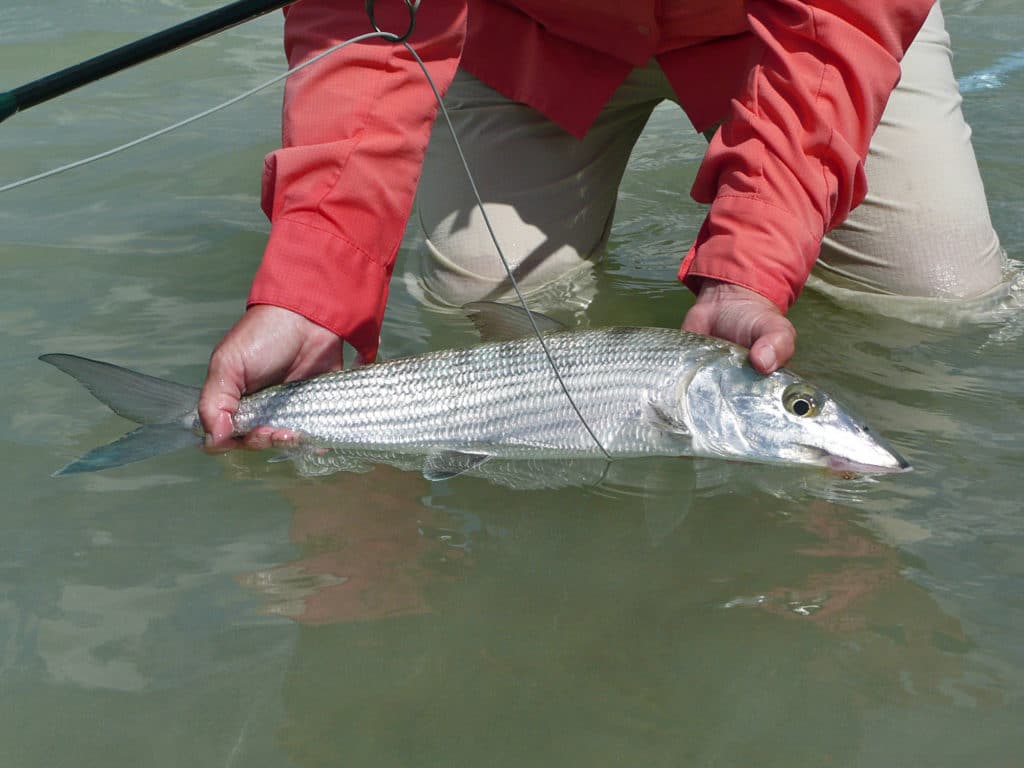
After 50-plus years of fly fishing and tying, I have come to the conclusion that many fly fishers derive some kind of comfort from an overstuffed fly box. Some, however, are more Spartan in their approach, depending wholly on a handful of effective patterns.
I have run that gamut, and am now quite Spartan. Since most flies will work on multiple species, I mostly fish with a half dozen fly patterns for inshore saltwater game, though I may carry a few color and size variations of my favorites.
A small, versatile selection of baitfish, shrimp and crab patterns make up what I call “The Magnificent 7.” Like the great western classic of the same name, I believe one must be armed with the right weapons. And, while I don’t rank these flies in any particular order, you can be sure I carry them every single one in my flats skiff.
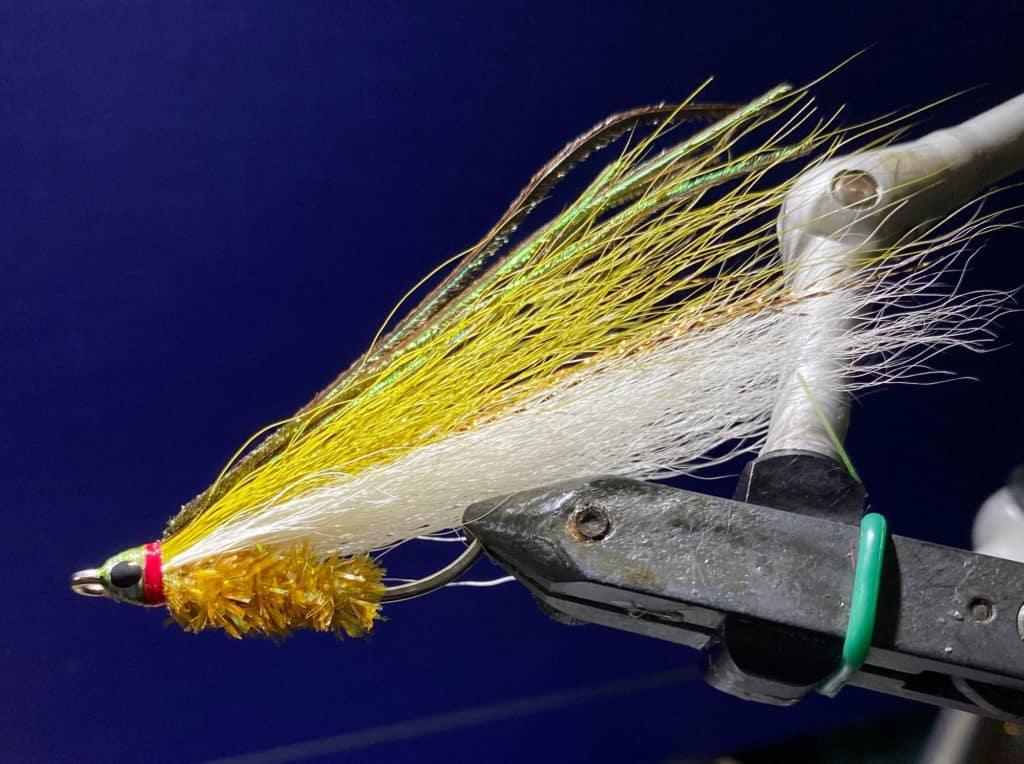
Prince of Tides Bendback
Like any Bendback style pattern, the Prince of Tides requires you to bend the hook shank back a little, and features a wing tied on the inside of the hook gap, which makes the fly ride with the hook point up to prevent it from snagging seagrass. Depending on the color of the material you use, be it natural, synthetic, or a combination of both, this fly can imitate baitfish or shrimp. Avoid bending the hook shank too deeply, or the wing will not protect the hook point as well, and setting the hook will be harder.
A true Florida backcountry classic, the Prince of Tides was popularized by Flip Pallot, and is a great choice for redfish, snook and spotted seatrout. The original version is sports a bucktail wing and peacock herl as a topping, adding the iridescent back seen on many live baitfish. Flash is optional. I add Krystal Flash, but not a lot of it. You don’t have to wrap the hook shank with chenille, though it’s traditional to do so. The thread on the head of the fly is coated with cement and, once it dries, you can paint a pair of eyes for a more realistic appearance.
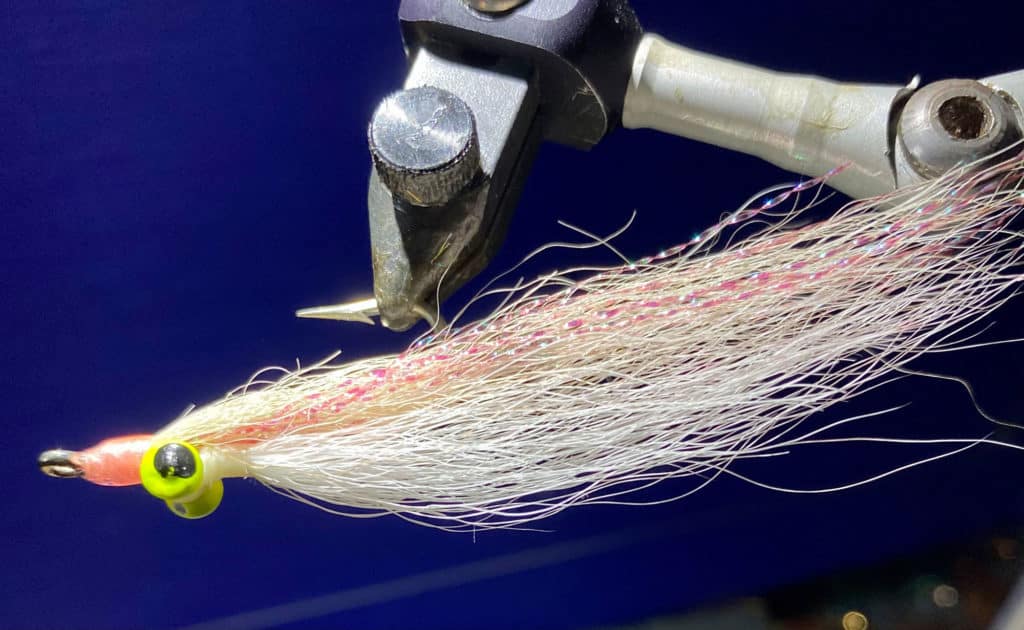
Clouser Deep Minnow
Pennsylvania fly fisher and fly shop owner Bob Clouser had a magnificent moment in 1985 when he first tied lead dumbbell eyes to the underside of a hook shank and came up with this simple baitfish pattern to fool smallmouth bass. Clouser tied this fly to sink quickly in moving water, so the late Lefty Kreh called it the Clouser Deep Minnow. Its standard lead dumbbell eyes make it sink like a jig, but a slower sink rate is easily achieved by swapping the lead eyes with bead-chain eyes. The fly, by the way, sinks best when tied sparsely, either with bucktail or any of the synthetic wing materials available.
A tan-and-white version is among my go-to flies for snook in the surf, and I have also taken many bonefish on ocean-side flats with it. For sharp-toothed species such as bluefish or Spanish mackerel, I tie Clousers on long-shank hooks, with the head and eyes an inch or more back from the hook eye, to help protect the mono leader from cut-offs.
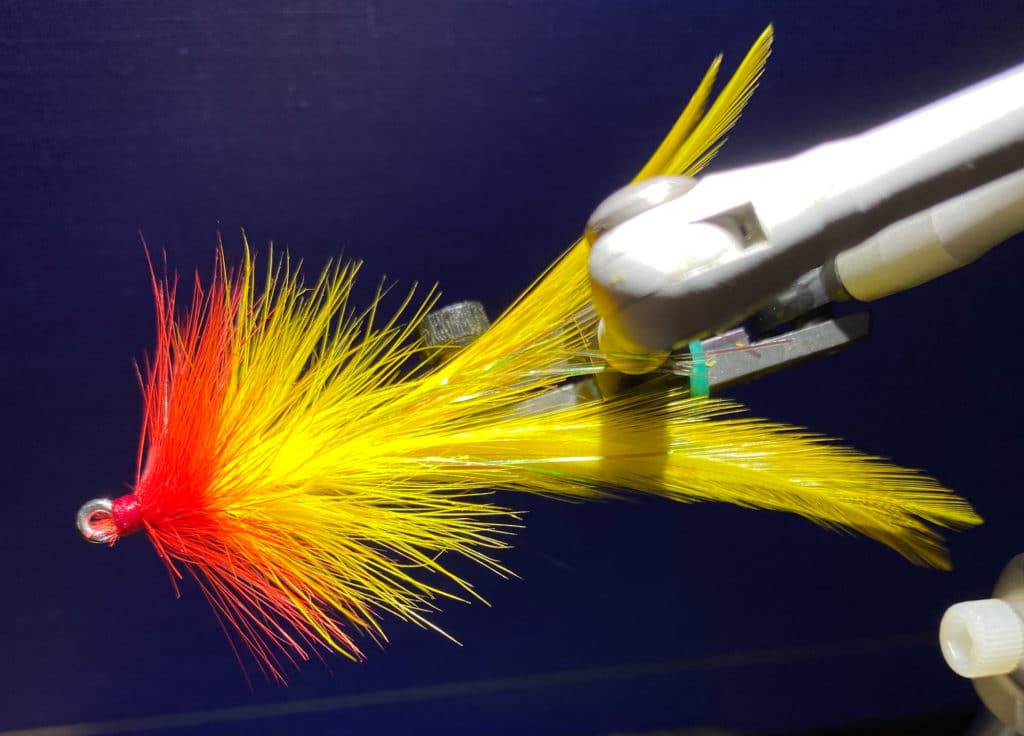
Sea-Ducer
Chico Fernandez came up with the modern name Sea-Ducer for this iconic hackle streamer, originally known as the Homer Rhode Tarpon Streamer, after the late Homer Rhode Jr., who came up with the pattern and made it famous fishing not just for tarpon, but also big snook in Everglades ditches and canals.
This fly can be tied in colors to imitate baitfish or shrimp, and it excels in shallow water due to the buoyancy provided by its palmered hackle head, which also affords some hook point protection. But for casting along tree-lined shorelines, adding a mono weed guard is recommended. The fly’s split wings are fashioned with hackle divided and splayed outward for a breathing effect and seductive undulating in a current, easily achieved with very little stripping. Great fished at the surface, or presented with a sinking line, the Sea-Ducer is terrific for snook, tarpon, redfish, striped bass, dolphin and cobia, and can be tied on hooks ranging in size from 2 to 3/0, depending on the target species.
I really like it for fishing flats potholes or shoreline pockets where fish lie in ambush and the strike zone is small.
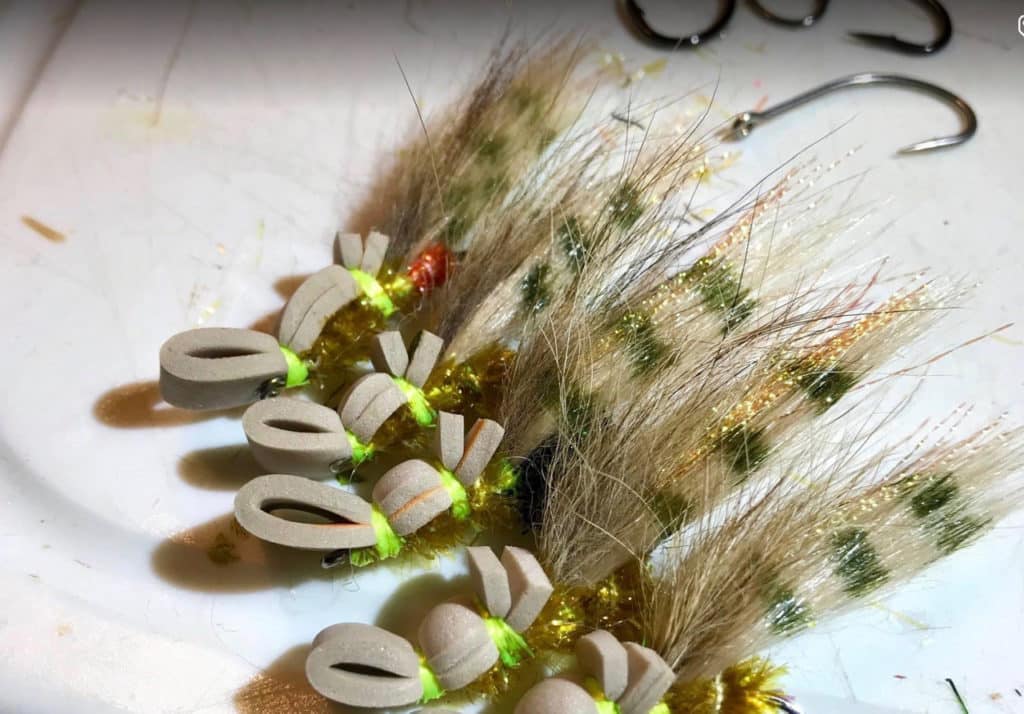
Gartside Gurgler
Everybody loves a surface strike, but not everyone wants to chuck hard-headed poppers all day. The Gartside Gurgler, designed by the late Jack Gartside some 25 years ago, is an excellent topwater option that imitates either a struggling baitfish or a shrimp skipping at the surface. This foam-strip fly casts like a feather. The foam strip is propped up at the head to form a “gurgling” lip. It is much easier to increase the size profile, and to make it “plane” better on the cast, tie in a tail at least as long as the overall foam strip body and head. This longer and stiffer tail supports it in the air. The foam body can be tied in singly on small flies, but I often tie the head in double-stacked fashion for better flotation. Tied on 2 through 2/0 standard or 2X long-shank hooks, the fly’s overall length is usually 4 to 6 inches long.
Spotted seatrout, striped bass, red drum, snook, jacks, and tarpon fall all over the Gurgler, which has become my favorite surface fly for baby tarpon. I find that jumping fish don’t throw this foam fly as readily as heavier poppers.
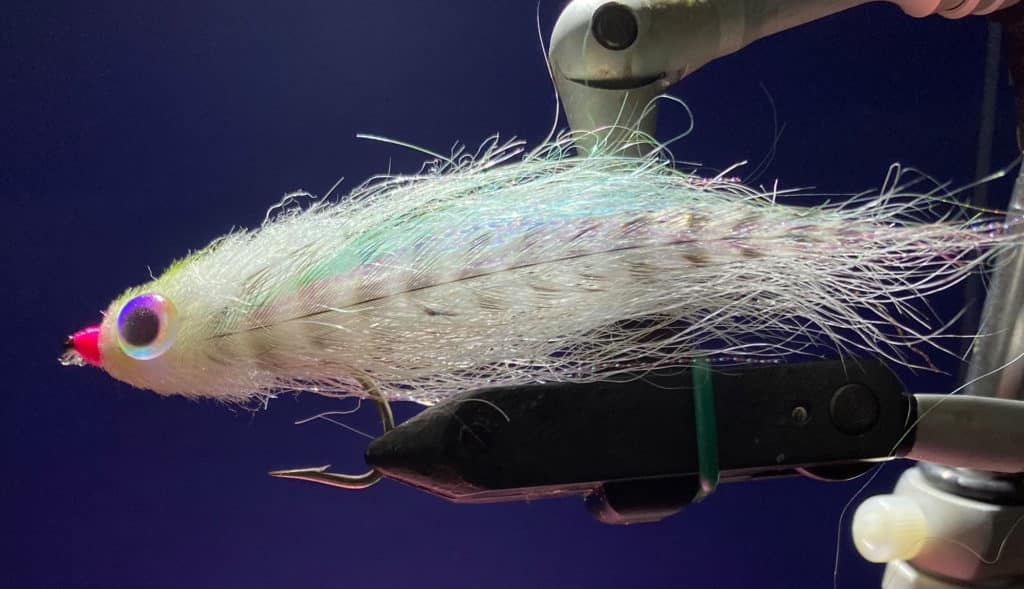
Midnight Mullet
Pardon the self-promotion, but I have tweaked some very good mullet patterns over the years, and this one (trademarked and sold as Conner’s Midnight Mullet by Umpqua Feather Merchants) has fooled many 10-pound-plus snook for me in both the surf during the day, and under bridges at night. I tied it in white, it’s my sole big-snook fly.
When I first saw palmering flash chenille in fly shops, I went to work and replaced the traditional lamb’s wool and deer belly hair which is standard in many baitfish flies. I like the iridescence of the material, and it can be trimmed and shaped just like wool. I prefer top quality bucktail for the wing, sparse flash (though I go heavier on the material for night fishing under lighted bridges), and I may add a grizzly hackle to each side to mimic scales. I sometimes add a topping of olive bucktail, but it’s not a must. After I trim the head to shape, I add dome decal eyes with a hot glue gun. I also tie this pattern in purple or black for night fishing, and sometimes I use a chartreuse head for the surf, where I fish for big snook and tarpon on foot. My favorite hook size is 1/0, and for occasions when snook or tarpon are swimming a bit deeper along the beach, I tie a few with lead fuse wire wrapped along the hook shank beforehand.
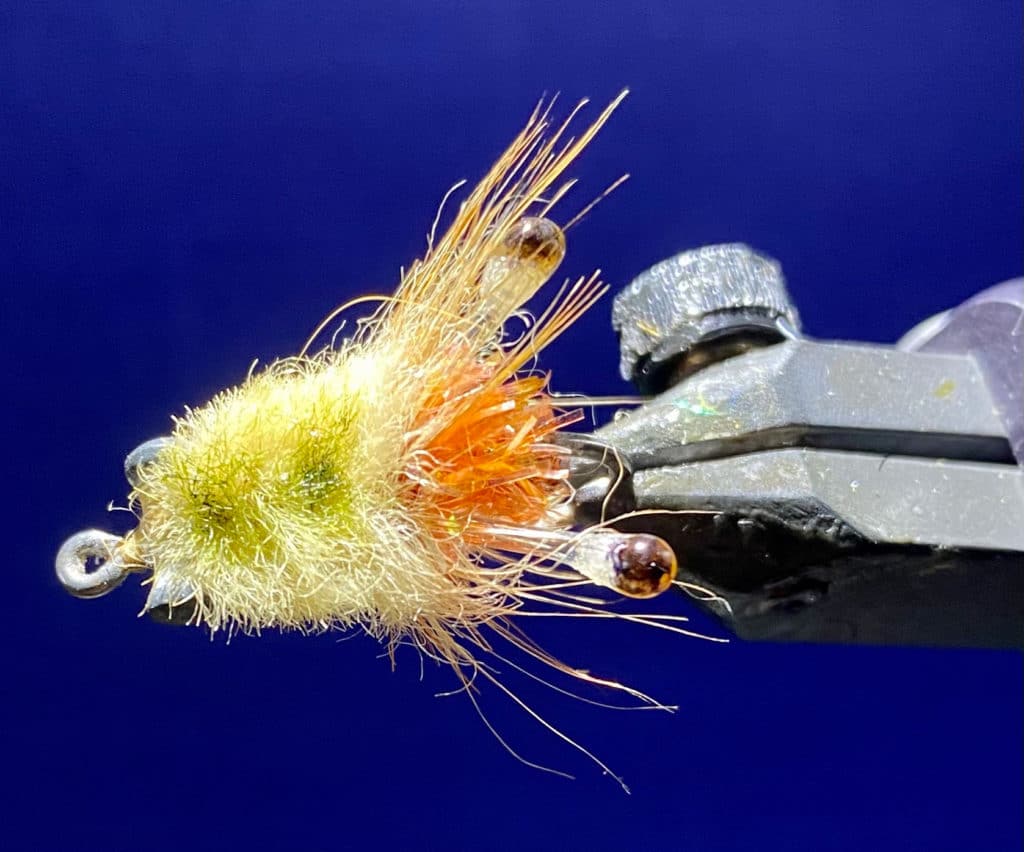
Borski Critter Crab
Magnificently simple, this Tim Borski crab pattern has reserved space in every fly box I carry. Actually, I’ve never met a Borski creation I didn’t like or fish at one time or another. The Critter Crab raises eyebrows the first time some fly fishers see it. “That’s it?” I’ve heard them say. I never understood why some fly rodders insist on intricate, lifelike crab flies that take an hour to tie.
The first one I saw was tied Chris Dean of Miami, and soon after, I started catching Biscayne Bay bonefish on the pattern. Then I realized the fly really shined for tailing reds in Florida Bay on still summer days, when the fish are fussy as hell, and refuse bigger offerings. The No. 4 size is my favorite, and I rarely fish anything but the standard tan version with the tuft of orange sparkle chenille at the hook bend. I think the mono eyes are the key, they really stand out on this otherwise sparsely tied crab pattern. This fly can be weighted with small bead chain or the smallest lead dumbbell eyes, or fished unweighted for those skittish tailers in the skinniest water. I usually add a single-post mono weed guard for good measure.
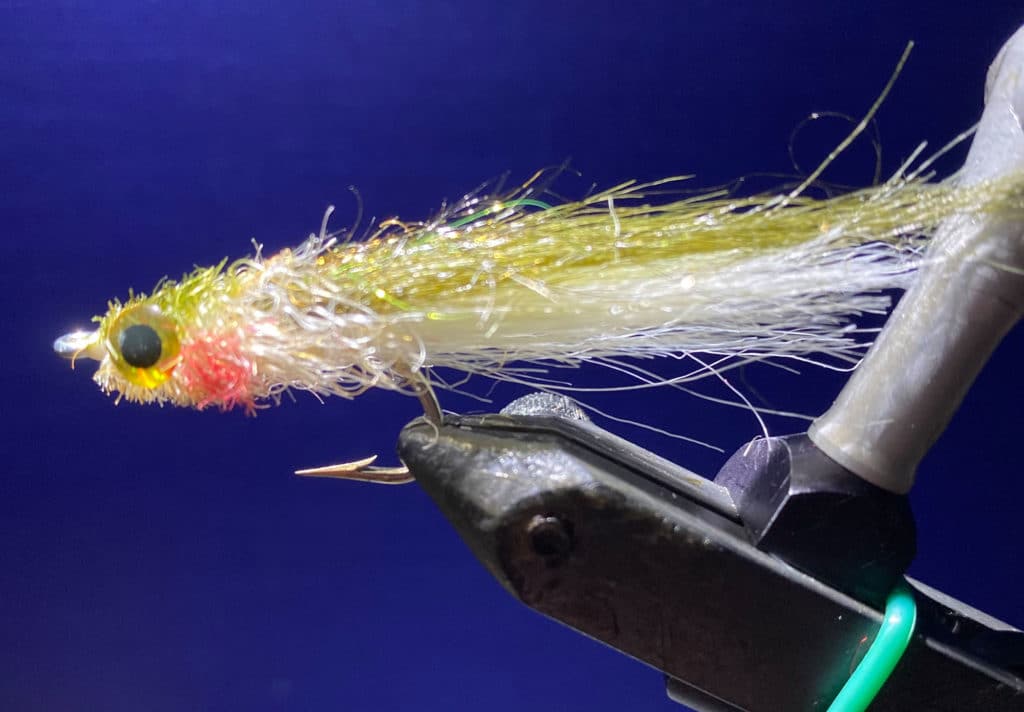
Glades Minnow
Okay, one more plug for the author. The Glades Minnow is among the earliest of my traditional fly pattern tweaks. In the early 80s, I fished for snook and baby tarpon in roadside canals all the way from west Miami to Marco Island, and the main forage was gambusia minnows, also called mosquito minnows. Falling tides from Everglades prairies carried tons of these 1- to 2-inch morsels into the canals, where hungry fish —along with flocks of herons and egrets— congregated for the feast. Those could get pretty selective and, while I did quite well with a good ol’ Muddler Minnow of trout stream fame, I eventually went to the vise and came up this minnow imitation made entirely of Craft Fur, which I was using for a number of my bonefish flies at the time. A little gold Mylar wrap for the hook shank, a tan over white Craft Fur wing for the body, and instead of wool to spin and shape the head, I used the more crinkly fur closest to the Craft Fur patch, after discovering that I could tie it down and make it flare like deer hair. I tied in two or three small tufts, then clipped to a bullet shape, and added two red-and-black decals eyes to finish this great Gambusia Minnow imitation.
The next morning, I arrived at a canal bank where birds were in a frenzy and the surface was alive with fish busts. I don’t recall getting a single refusal in three hours, and lost as many little tarpon and snook as I landed. I had brought 4 of the flies and none made the return trip to Miami. Eventually, I pitched the pattern to Umpqua, and they still produce it today. In Stuart, Florida, where I now live, the Glades Minnow in sizes 4 and 6 remains one of the best dock-light snook flies.









